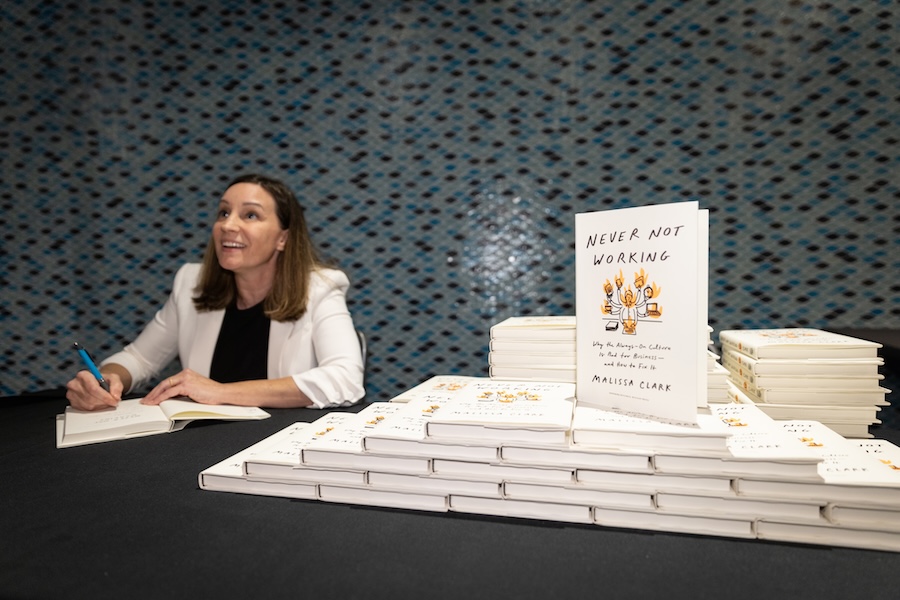Does Your Corporate Culture Promote Overwork? How to Tell–And How to Fix It


When Malissa Clark was in graduate school, she went into labor with her first child right before spring break. Instead of going to the hospital right away, she waited until her contractions were less than six minutes apart so she could finish a midterm.
“I spent a couple more hours at the coffee shop, occasionally doubled over,” she said during a fireside chat at From Day One’s conference in Atlanta.
Clark told moderator Nicole Smith of the Harvard Business Review that “I didn’t feel like I could stop. I didn’t feel like I could ask for support. I just felt like I had to push through.”
At the time Clark realized she had a problem. However, she said she didn’t really address it until she began writing her book, Never Not Working: Why the Always-On Culture is Bad for Business – and How to Fix It and doing research on workaholism.
Today, many people are feeling burned out in their careers and are trying to find a healthier work-life balance. However, workplace culture far too often gets in the way, says Clark.
“Companies just aren’t listening to employees,” she said. Despite people learning during the pandemic that they could do their jobs from home and be productive, organizations are still pessimistic about remote work and insisting workers return to the office.
“One of the biggest misconceptions about burnout is that the employee is just not managing stress well enough and needs to learn more coping skills and mindfulness, and then they can handle this,” Clark said. “That’s just not accurate. It’s the organizational and societal factors that are the stressors building on top of each other, and cumulative stress has a toll on our bodies.”
When individual employees are overworked, it lowers not only their performance but that of others, says Clark. “You’re not as good of a teammate or boss, and so that hinders the morale of the group,” she said.
Breaking the “Always On” Mentality
A key contributor to the current culture of overwork is the belief that employees should be available 24/7, says Clark. Sometimes this attitude comes from the top of the organization, but lower-level employees can perpetuate it.
“I think during Covid, we learned some bad habits,” she said. For example, parents who had to supervise their children during the day tended to contact their colleagues in the evenings about work, which put pressure on those colleagues to respond.
Clark says some companies are encouraging those who have different work hours than other team members to go ahead and write the emails, but to use the schedule send feature so they aren’t received outside of working hours.
Incentives for Using Vacation Time
Another way employers can promote a healthy work-life balance is by encouraging workers to take paid time off. However, offering unlimited vacation days doesn’t work, says Clark, noting companies that have tried this found employees were taking even less PTO than before.

Some companies are finding innovative solutions to encourage workers to use their PTO. Medtronic found a way to encourage employees to use their allotted days. In their ‘Earn Time to Win Time’ program, the more workers use their vacation time, the more opportunities they have to enter drawings to win even more days off.
“It’s like a positive reinforcement for actually taking vacations,” Clark said. “I thought that was pretty ingenious.”
The Four-Day Week Movement
Several years ago, some companies began experimenting with four-day work weeks, in which employees worked 32 hours a week but were paid the same as they would have been for a 40-hour week. Revenue at those companies grew, while 70% of workers reported less burnout, according to data and employee surveys.
“Almost every single employee said they wanted to continue with this,” Clark said. “One of the most astounding things is that 15% said they would not go back to a five-day week for any amount of money. It was life-changing for them.”
A 32-hour work week doesn’t have to mean working eight hours a day, four days a week, says Clark. It can be five days a week from 8:30 am to 3:00 pm, which is popular with parents.
“We don’t need to be working 40 hours a week,” Clark said. “We have technology, we have AI, we have all these tools that help us to be more productive. We equate hours worked with productivity, and we need to stop doing that.”
Mary Pieper is a freelancer reporter based in Mason City, Iowa.
The From Day One Newsletter is a monthly roundup of articles, features, and editorials on innovative ways for companies to forge stronger relationships with their employees, customers, and communities.